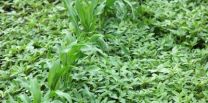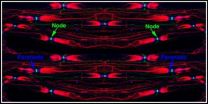(Press-News.org) Waterhemp has done it again. University of Illinois researchers just published an article in Pest Management Science confirming that waterhemp is the first weed to evolve resistance to HPPD-inhibiting herbicides.
"A fifth example of resistance in one weed species is overwhelming evidence that resistance to virtually any herbicide used extensively on this species is possible," said Aaron Hager, U of I Extension weed specialist.
Waterhemp is not a weed species that can be adequately managed with one or two different herbicides, Hager said. This troublesome weed requires a much more integrated approach.
"Large-scale agronomic crop production systems currently depend on herbicides for weed management," Hager said. "A weakness in this approach lies in its strength; because herbicides are so effective, they exert tremendous selection pressures that, over time, result in resistant weed populations as natural outcomes of the evolutionary process."
In an article in the Journal of Agricultural and Food Chemistry, Hager and Pat Tranel, a U of I professor of molecular weed science in the Department of Crop Sciences, shared the results of a survey of multiple-herbicide resistance in waterhemp. The results showed that all populations resistant to glyphosate were also resistant to ALS inhibitors and 40 percent contained resistance to PPO inhibitors.
Adding HPPD resistance to the mix complicates problems for growers and scientists. When weeds stack several forms of resistance, it greatly reduces the number of viable herbicide options.
"We are running out of options," Hager said. "This multiple-herbicide resistance in waterhemp has the potential to become an unmanageable problem with currently available postemergence herbicides used in conventional or glyphosate-resistant soybean."
Hager said they've already discovered one waterhemp biotype that's resistant to four different herbicide families. He said growers may see five-way resistance in the future.
Fortunately, there are very few annual weed species in the United States that have shown this level of multiple resistance. Waterhemp is a dioecious species and ideally suited for evolving herbicide resistance by sharing resistance genes among populations and biotypes.
"For example, you can have HPPD resistance evolving in field A, and in adjacent field B you can have selection for glyphosate resistance," Tranel said. "Pollen is always moving in the air, allowing pollen from field A to mix with resistant plants from field B resulting in HPPD and glyphosate resistance in the same progeny. That's how easy it is to stack resistance."
The pressure is on for industry to develop new options and for growers to change their practices of how they use products to control the weed spectrum, he added.
Hager, Tranel and Dean Riechers, a U of I associate professor of herbicide physiology, were recently awarded a grant from Syngenta to study how waterhemp populations evolve resistance. They will collaborate with Syngenta's scientists to find answers regarding the genetics, inheritance, and mechanisms of resistance to HPPD inhibitors.
"We are excited for the opportunity to collaborate with industry to learn more about these resistant biotypes," Tranel said. "We want to find practical management recommendations for growers."
Hager said that there is only so much a person can learn by looking at different treatments in a field, but if this is not done, it's difficult to come up with the best recommendations. The U of I weed science team's advantage is their ability to span the range from applied field and greenhouse work to basic DNA sequencing, physiology and genetics work.
At least two companies are developing crop varieties that are resistant to HPPD inhibitors. In the future, both of these companies see HPPD-inhibiting herbicides growing in importance.
"We now have known resistance before the resistant crops are on the market," Tranel said. "That's a real concern."
But Hager thinks it could be a blessing in disguise.
"We have time to learn about this type of resistance in advance before these crop varieties hit the market," Hager said. "If these crops are commercialized, we could have the recommendations in place from the onset to slow the evolution of this resistance."
INFORMATION:
Their research, "Resistance to HPPD-inhibiting herbicides in a population of waterhemp from Illinois, USA," was published online on January 26 in Pest Management Science. Researchers include Tranel, Hager, Dean Riechers, Nicholas Hausman, and Sukhvinder Singh of the U of I; and Shiv Kaundun, Nicholas Polge and David Thomas of Syngenta.
"Herbicide Resistances in Amaranthus tuberculatus: A Call for new Options" was published online in November 2010 by the Journal of Agricultural and Food Chemistry. Researchers included Tranel, Hager, Chance Riggins and Michael Bell of the U of I.
Waterhemp rears its ugly head ... again
2011-01-27
ELSE PRESS RELEASES FROM THIS DATE:
Agave fuels global excitement as a bioenergy crop
2011-01-27
Scientists found that in 14 independent studies, the yields of two Agave species greatly exceeded the yields of other biofuel feedstocks, such as corn, soybean, sorghum, and wheat. Additionally, even more productive Agave species that have not yet been evaluated exist.
According to bioenergy analyst, Sarah Davis, "We need bioenergy crops that have a low risk of unintended land use change. Biomass from Agave can be harvested as a co-product of tequila production without additional land demands. Also, abandoned Agave plantations in Mexico and Africa that previously supported ...
The undead may influence biodiversity, greenhouse gas emissions
2011-01-27
EAST LANSING, Mich. — It's commonly known, at least among microbiologists, that microbes have an additional option to living or dying — dormancy.
Dormant microbes are less like zombies and more like hibernating bears. What isn't known, however, is how large numbers of dormant microorganisms affect the natural environments when they act as microbial seed banks. In the current issue of Nature Reviews: Microbiology, Jay Lennon, Michigan State University assistant professor of microbiology and molecular genetics, examines the cellular mechanisms that allow microbes to hibernate ...
RIC study suggests researchers are entering a new era of advances in brain research
2011-01-27
CHICAGO (January 26) – Scientists at The Rehabilitation Institute of Chicago (RIC), designated the "#1 Rehabilitation Hospital in America" by U.S. News & World Report since 1991, report that, thanks to improvements in technology and data analysis, our understanding of the functional principles that guide the development and operation of the brain could improve drastically in the next few years. The advances could herald a neuroscientific revolution, much as increasing processor speeds paved the way for the computing revolution of the last half century.
In the February, ...
Stimulating the brain's immune response may provide treatment for Alzheimer's disease
2011-01-27
A new target for the prevention of adverse immune responses identified as factors in the development of Alzheimer's disease (AD) has been discovered by researchers at the University of South Florida's Department of Psychiatry and the Center of Excellence for Aging and Brain Repair.
Their findings are published online in the Journal of Neuroscience (http://www.jneurosci.org/).
The CD45 molecule is a receptor on the surface of the brain's microglia cells, cells that support the brain's neurons and also participate in brain immune responses.
Previous studies by the ...
Membrane molecule keeps nerve impulses hopping
2011-01-27
CHAPEL HILL, N.C. -- New research from the University of North Carolina at Chapel Hill School of Medicine describes a key molecular mechanism in nerve fibers that ensures the rapid conductance of nervous system impulses. The findings appear online Jan. 27, 2011 in the journal Neuron.
Our hard-wired nerve fibers or axons rely on an insulating membrane sheath, the myelin, made up of fatty white matter to accelerate the rate of transmission of electrical impulses from the brain to other parts of the body.
Myelin thus acts to prevent electrical current from leaking or prematurely ...
Discovery of a biochemical basis for broccoli's cancer-fighting ability
2011-01-27
Scientists are reporting discovery of a potential biochemical basis for the apparent cancer-fighting ability of broccoli and its veggie cousins. They found for the first time that certain substances in the vegetables appear to target and block a defective gene associated with cancer. Their report, which could lead to new strategies for preventing and treating cancer, appears in ACS' Journal of Medicinal Chemistry.
Fung-Lung Chung and colleagues showed in previous experiments that substances called isothiocyanates (or ITCs) — found in broccoli, cauliflower, watercress, ...
First report on fate of underwater dispersants in Deepwater Horizon oil spill
2011-01-27
Scientists are reporting that key chemical components of the 770,000 gallons of oil dispersants applied below the ocean surface in the Deepwater Horizon spill did mix with oil and gas spewing out of the damaged wellhead and remained in the deep ocean for two months or more without degrading. However, it was not possible to determine if the first deep ocean use of oil dispersants worked as planned in breaking up and dissipating the oil. Their study, the first peer-reviewed research published on the fate of oil dispersants added to underwater ocean environments, appears in ...
Getting more anti-cancer medicine into the blood
2011-01-27
Scientists are reporting successful application of the technology used in home devices to clean jewelry, dentures, and other items to make anticancer drugs like tamoxifen and paclitaxel dissolve more easily in body fluids, so they can better fight the disease. The process, described in ACS' journal, Langmuir, can make other poorly soluble materials more soluble, and has potential for improving the performance of dyes, paints, rust-proofing agents and other products.
In the report, Yuri M. Lvov and colleagues point out that many drugs, including some of the most powerful ...
Fish smile but some consumers frown at new genre of phosphate-free detergents
2011-01-27
Phosphate-free automatic dishwashing detergents — introduced to combat the phosphate-fed algae blooms that foul the nation's lakes and rivers — may be making the fish happy. But they're putting a frown on the faces of some consumers who say the new products leave dishes dirty. That's the topic of the cover story in the current edition of Chemical & Engineering News (C&EN), ACS' weekly newsmagazine.
C&EN Assistant Managing Editor Michael McCoy described how new laws in 16 states require manufacturers to eliminate phosphates from automatic dishwasher detergents sold in ...
Hubble finds a new contender for galaxy distance record
2011-01-27
Astronomers have pushed the NASA/ESA Hubble Space Telescope to its limits by finding what is plausibly the most distant and ancient object in the Universe [1] ever seen. Its light has travelled for 13.2 billion years to reach Hubble [2], which corresponds to a redshift around 10. The age of the Universe is 13.7 billion years.
The dim object, called UDFj-39546284, is likely to be a compact galaxy of blue stars that existed 480 million years after the Big Bang, only four percent of the Universe's current age. It is tiny. Over one hundred such mini-galaxies would be needed ...



